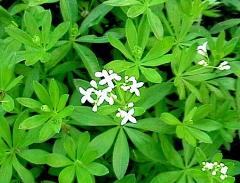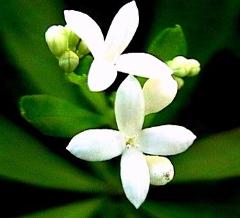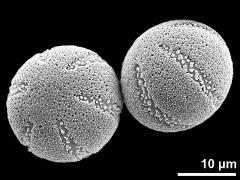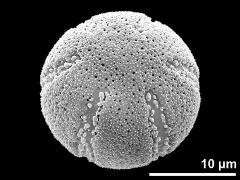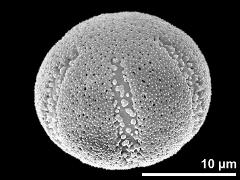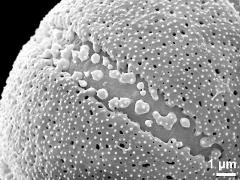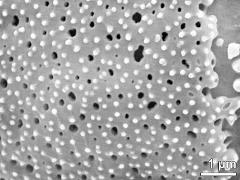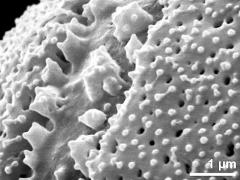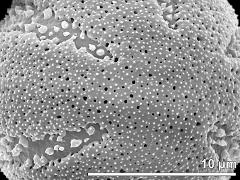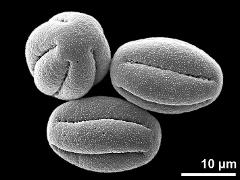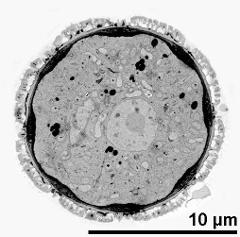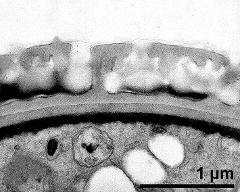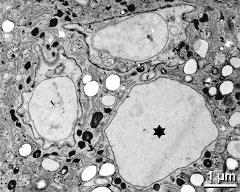Galium odoratum
Taxonomy: Spermatophyta, Gentianales, Rubiaceae, Galium
Published: 2005-06-01
Pollen Description
Shape, Size and Aperture
pollen unit: monad, dispersal unit and peculiarities: monad, size (pollen unit): small (10-25 µm), size of hydrated pollen (LM): -, shortest polar axis in equatorial view (LM): -, longest polar axis in equatorial view (LM): -, shortest diameter in equatorial or polar view (LM): -, longest diameter in equatorial or polar view (LM): -, pollen class: colpate, polarity: isopolar, P/E-ratio: oblate, shape: -, outline in polar view: circular, dominant orientation (LM): -, P/E-ratio (dry pollen): prolate, shape (dry pollen): -, outline in polar view (dry pollen): circular, infoldings (dry pollen): aperture(s) sunken, aperture number: 6, aperture type: -, aperture condition: colpate, aperture peculiarities: aperture membrane ornamented, stephanoaperturate
Ornamentation and Structure
LM ornamentation LM: -, nexine: -, sexine: -, SEM ornamentation SEM: microechinate, perforate, suprasculpture SEM: -, TEM tectum: eutectate, infratectum: columellate, foot layer: continuous, endexine: compact-continuous, intine: monolayered, wall peculiarities: -, supratectal element: -
Miscellaneous
pollen coatings: pollenkitt, reserves in cytoplasm: starch, polysaccharide vesicles, cell number: 3-celled, Ubisch bodies: absent
Annotations: aperture nr up to 8; microechinate surface sculpturing
Author(s) of diagnosis: Halbritter, H.; Weber, M.
Pictures
Picture legend
- habitus, photographer: Weber, M.
- flower(s), photographer: Weber, M.
- hydrated pollen grains - fresh, rehydrated (water) & critical point dried & sputter coated with gold, photographer: Halbritter, H.
- polar view (oblique) - fresh, rehydrated (water) & critical point dried & sputter coated with gold, photographer: Halbritter, H.
- equatorial view - fresh, rehydrated (water) & critical point dried & sputter coated with gold, photographer: Halbritter, H.
- aperure - fresh, rehydrated (water) & critical point dried & sputter coated with gold, photographer: Halbritter, H.
- exine surface - fresh, rehydrated (water) & critical point dried & sputter coated with gold, photographer: Halbritter, H.
- detail of aperture - fresh, rehydrated (water) & critical point dried & sputter coated with gold, photographer: Halbritter, H.
- polar area - fresh, rehydrated (water) & critical point dried & sputter coated with gold, photographer: Halbritter, H.
- dry pollen grains - dry, sputter coated with gold, photographer: Halbritter, H.
- total view of pollen grain; note apertural intine thickenings - fresh, glutaraldehyde & osmium & potassium ferrocyanide, uranyl acetate & lead citrate, photographer: Weber, M.
- pollen wall - fresh, glutaraldehyde & osmium & potassium ferrocyanide, uranyl acetate & lead citrate, photographer: Weber, M.
- vegetative nucleus (asterisk) and 2 sperm cells - fresh, glutaraldehyde & osmium & potassium ferrocyanide, modified Thiéry-test, photographer: Weber, M.
Literature
- (1975) Morphologie, Biologie und Abgrenzung von Galium L. sect. Aparinoides (Jord.) Gren. (Rubiaceae). Beitr Biol Pflanzen 51: 17-40
- (1988) Formation of sperm cells in Galium mollugo (Rubiaceae), Trichodiadema setuliferum (Aizoaceae), and Avena sativa L. (Poaceae). Pl Syst Evol 161: 53-64
Copyright and Citation
Cite this publication as:
Halbritter H., Weber M. 2005. Galium odoratum. In: PalDat - A palynological database. https://www.paldat.org/pub/Galium_odoratum/109045;jsessionid=84E0677E03D9B1802A5AE386A51B812A; accessed 2024-04-20

